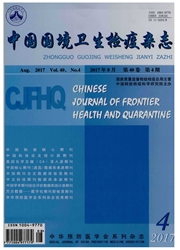

 中文摘要:
中文摘要:
目的 分析深圳市出入境人群HIV感染特征,为深圳市的HIV防控工作提供科学数据.方法 统计2008-2012年深圳口岸出入境人群的HIV抗体检测情况和HIV-1抗体阳性者数据,并与深圳口岸既往检测数据和深圳市HIV流行病学资料进行比较.组间率的比较采用x2检验,均数比较采用t检验.结果 2008-2012年,深圳口岸共对346 354人检测了HIV,其中HIV抗体阳性81人(0.2‰).与深圳口岸既往检测数据相比,HIV抗体阳性率有所升高,但差异无统计学意义;与深圳地区同期HIV检测数据相比,HIV-1抗体阳性率较低,差异有统计学意义.传播途径以异性性传播途径和同性/双性性传播为主,各占39.5%和19.8%.深圳出入境人群HIV感染者男性比例、受教育程度均高于深圳市同期水平,差异有统计学意义.结论 深圳出入境人群中HIV感染水平与深圳市同期相比处于低流行水平,感染途径以性途径占多数,应重视相关人群的健康教育工作.
 英文摘要:
英文摘要:
Objective To explore HIV infection characteristics at Shenzhen port and provide scientific data for Shenzhen HIV prevention and control.Methods HIV antibody testing results and epidemiologic characteristics among entry-exit personnel at Shenzhen port from 2008 to 2012 were analyzed and compared with previous data of Shenzhen port and Shenzhen local area's epidemic data of the same period.x2-tests were used to compare rates.t-tests were used to compare means.Results From 2008 to 2012, 346 354 people at Shenzhen port had been tested for HIV with 81 people (0.2‰) being antibody positive.HIV prevalence rate had raise up mildly compared with five years ago, but with no significant difference.HIV prevalence rate during 2008-2012 was lower than Shenzhen local people's level and the difference had statistical significance.The main HIV transmission routes were heterosexual and homosexual/bisexual (39.5% and 19.8%, respectively).Both male and high education proportions of HIV infected people were higher than those in Shenzhen local area.Conclusions Sexual contact was the main transmission mode at Shenzhen port.More attention should be paid to related population's health education.
 同期刊论文项目
同期刊论文项目
 同项目期刊论文
同项目期刊论文
 期刊信息
期刊信息
